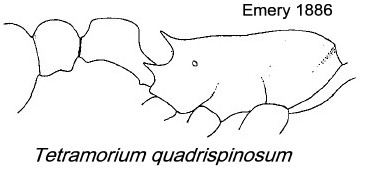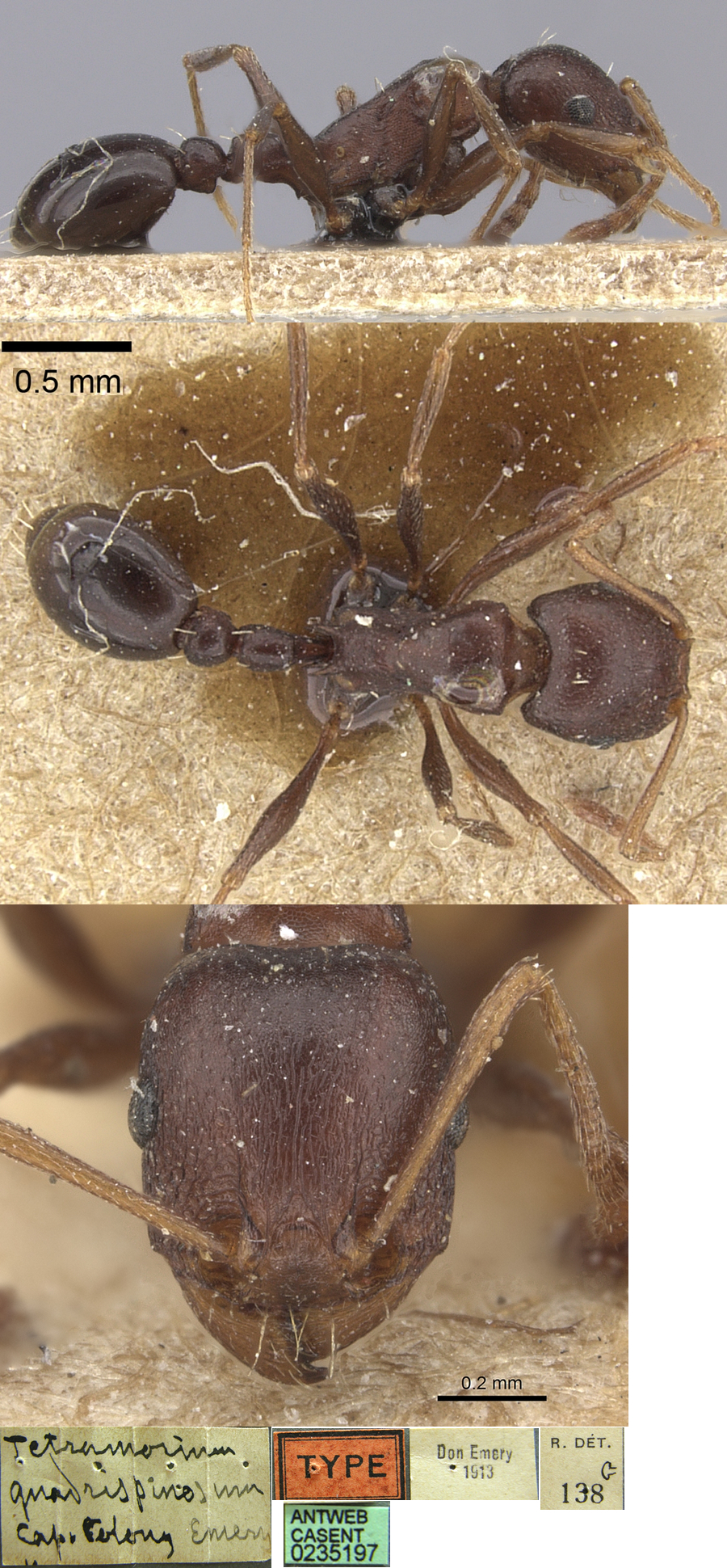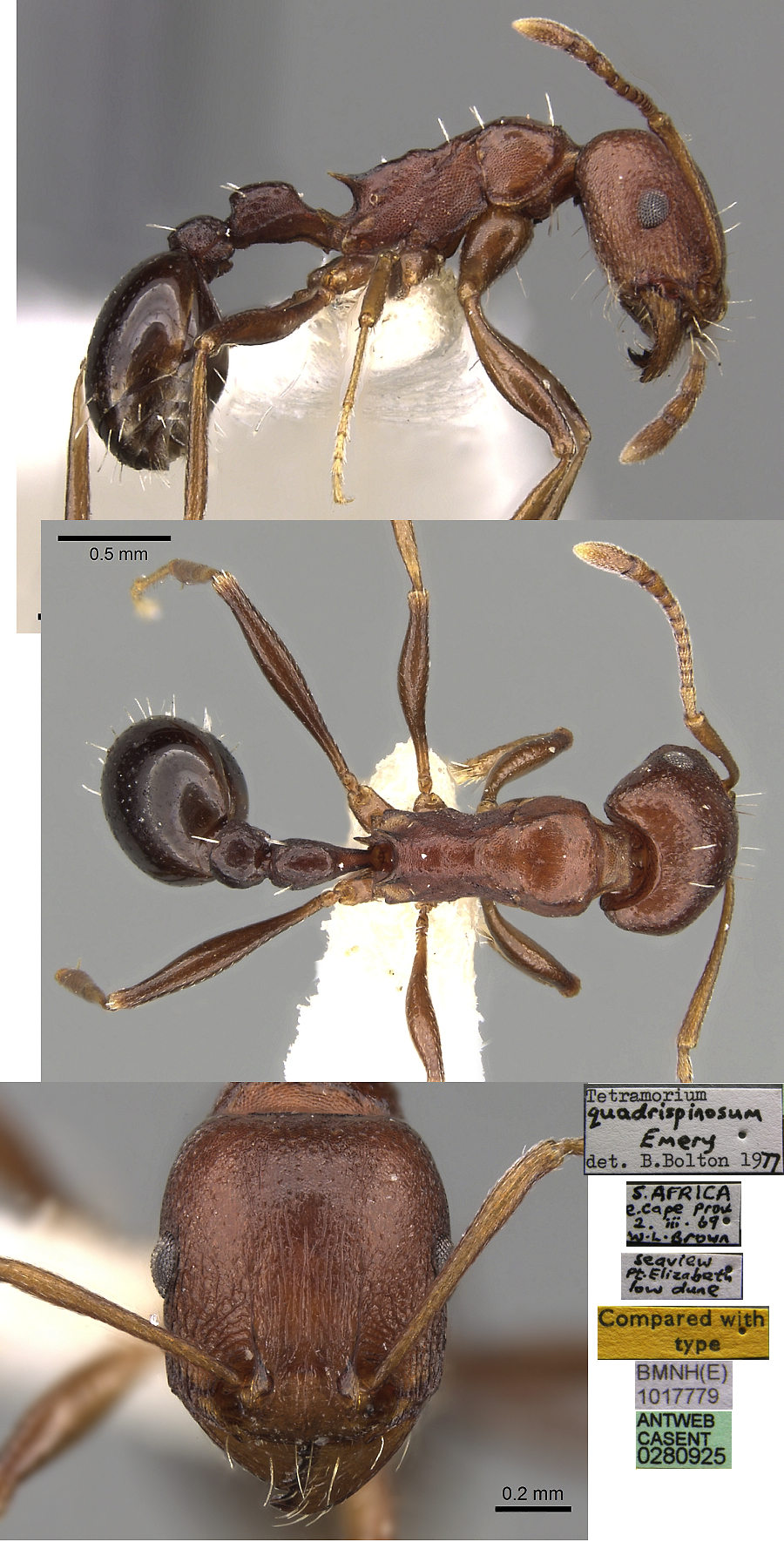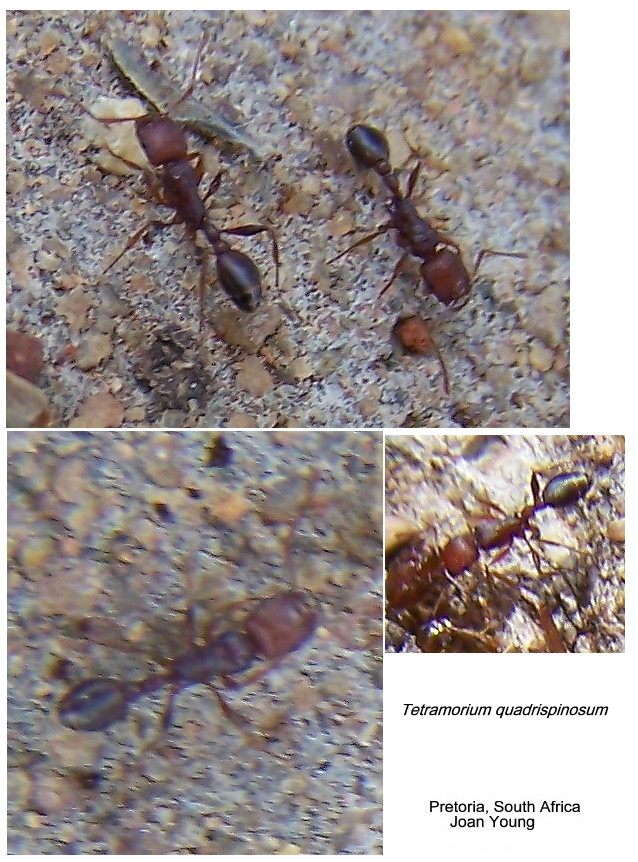Tetramorium quadrispinosum Emery
  Type location South
Africa (Tetramorium quadrispinosum
n. sp., Emery, 1886: 362, illustrated, worker) Type location South
Africa (Tetramorium quadrispinosum
n. sp., Emery, 1886: 362, illustrated, worker)
junior synonyms
montanum
(Tetramorium Blochmanni var. montanum nov. var., Forel,
1891b: 152, illustrated, worker)
from Madagascar - no images available on Antweb (June 2014).
angolense (Tetramorium
quadrispinosum Em. stirps angolense n. st., Santschi, 1930b:
71, worker
& queen) from Angola - no images available on Antweb (June
2014).
beirae (Tetramorium
quadrispinosum Emery race beirae
n. r., Arnold, 1926: 252,
worker) from Mozambique - see http://www.antweb.org/specimenImages.do?code=casent0901245
calvum (Tetramorium blochmanni For. var. calvum n.var., Stitz, 1923: 162,
worker) from Namibia - no images available on Antweb (June
2014).
eudoxia (Tetramorium Blochmanni For. r. continentis For. v. eudoxia n. var., Forel, 1914d: 231,
worker; Santschi, 1918b: 122 - see http://www.antweb.org/specimenImages.do?code=casent0909150;
and its junior synonym Tetramorium
4 spinosum Em.
stirps elegans n. st.,
Santschi, 1918b: 125, worker) from South Africa - see http://www.antweb.org/specimenImages.do?code=casent0901244
otaviensis
(Tetramorium quadrispinosum
Emery race otaviense n. r.,
Arnold, 1926: 253, worker) from Namibia - no images available on Antweb
(June 2014).
repertum (Tetramorium
sericeiventre Emery v. repertum
n. var., Santschi, 1926b: 242, worker) from Mozambique - see http://www.antweb.org/specimenImages.do?name=casent0235205
unavailable name benguelense
(Tetramorium quadrispinosum
Em. stirps elegans Sants v. benguelense n. v., Santschi, 1937d:
234, worker) from Angola - no images available on Antweb
(December 2014)
worker only described (see
Bolton, 1995)  . .
|
 Emery's (1886) description is at Emery's (1886) description is at  . Arnold (1917: 277) gave a translation,
this is at . Arnold (1917: 277) gave a translation,
this is at  . Forel's (1891b)
description of montanum is at . Forel's (1891b)
description of montanum is at  . Forel's (1914d) description of eudoxia
is at . Forel's (1914d) description of eudoxia
is at  . Arnold (1917: 277) gave
a translation of eudoxia, this is at . Arnold (1917: 277) gave
a translation of eudoxia, this is at  . Santschi's (1918b) description of elegans
is at . Santschi's (1918b) description of elegans
is at  . Arnold (1926: 277) gave
a translation of eudoxia, beirae and otaviensis,
this is at . Arnold (1926: 277) gave
a translation of eudoxia, beirae and otaviensis,
this is at  . Stitz's (1923)
description of calvum is at . Stitz's (1923)
description of calvum is at  . Santschi's (1926b) description of repertum
is at . Santschi's (1926b) description of repertum
is at  . Santschi's (1930b)
description of angolense is at . Santschi's (1930b)
description of angolense is at  . Santschi's (1937d)
description of benguelense is at . Santschi's (1937d)
description of benguelense is at  . Bolton's modern
description (1980) is at . Bolton's modern
description (1980) is at  . .
WORKER - TL 3.5 mm; generally more finely sculptured
than T.
sericeiventre and with a glossy gaster (Bolton, 1980: 330,
not illustrated). From the Elandskrans specimen shown below, also
differs in having
an evenly curved anterior to the pronotum when seen from above.
|
 The photomontage of
the type worker is collated from http://www.antweb.org/specimen.do?name=casent0235197. The photomontage of
the type worker is collated from http://www.antweb.org/specimen.do?name=casent0235197.
The almost identical type worker of repertum can
be seen at http://www.antweb.org/specimenImages.do?name=casent0235205.
|
 The photomontage of
a worker from South Africa in
the BMNH is collated from http://www.antweb.org/specimen.do?name=casent0280925.
It is some 35% bigger than the type or repertum.
The workers sent to me from South Africa and Sudan, see below, however,
are the same size. The reported sizes of the various varieties range
from under 3.0 to about 3.8 mm. The photomontage of
a worker from South Africa in
the BMNH is collated from http://www.antweb.org/specimen.do?name=casent0280925.
It is some 35% bigger than the type or repertum.
The workers sent to me from South Africa and Sudan, see below, however,
are the same size. The reported sizes of the various varieties range
from under 3.0 to about 3.8 mm.
Note the colour variation from bright chestnut to near black shown by the Sudan workers collected from a single transect (below)
|
Oxford University Museum
specimens
Tetramorium quadrispinosum
B Taylor det.
|
South Africa
S Danflous
|
16.xii.2007
Elandskrans
x°x'x" S
y°y'y" E
|
Western Cape; z m;
nest under a stone.
2 males & 2 workers
|
4
|
 |
Tetramorium quadrispinosum
B Taylor det. |
Sudan
Awatif Omer
2013.02.33
|
2013
Abu Hijar
12˚52' N
34˚0' E
|
very dark variant
|
2
|
 |
Tetramorium quadrispinosum
B Taylor det. |
Sudan
Awatif Omer
2014.07.1
|
Wad alaieiz
Sinjah
13˚09'0" N
33˚56'0" E
|
transect
|
1
|
|
Tetramorium quadrispinosum
B Taylor det. |
Sudan
Awatif Omer
2014.08
|
Wad alaieiz
Sinjah
13˚09'0" N
33˚56'0" E
|
transect
|
1
|
|
Tetramorium quadrispinosum
B Taylor det. |
Sudan
Awatif Omer
2014.16
|
Wad alaieiz
Sinjah
13˚09'0" N
33˚56'0" E
|
transect
|
2
|
|
Tetramorium quadrispinosum
B Taylor det. |
Sudan
Awatif Omer
2014.17
|
Wad alaieiz
Sinjah
13˚09'0" N
33˚56'0" E
|
transect
|
1
|
|
Tetramorium quadrispinosum
B Taylor det. |
Sudan
Awatif Omer
2014.21
|
Wad alaieiz
Sinjah
13˚09'0" N
33˚56'0" E
|
transect
|
2
|
|
Tetramorium quadrispinosum
B Taylor det. |
Sudan
Awatif Omer
2014.27
|
Wad alaieiz
Sinjah
13˚09'0" N
33˚56'0" E
|
transect
|
2
|
|
Tetramorium quadrispinosum
B Taylor det. |
Sudan
Awatif Omer
2014.34
|
Wad alaieiz
Sinjah
13˚09'0" N
33˚56'0" E
|
transect
|
2
|
|
|
 The
photomontage is
of workers from
South Africa, Elandskrans, Western Cape; collector Sam
Danflous; nest under a stone. The
photomontage is
of workers from
South Africa, Elandskrans, Western Cape; collector Sam
Danflous; nest under a stone.
|
 The
photomontage is
of male specimens collected from
South Africa, Elandskrans, Western Cape, S x°x'x" E y°y'y"; z m; Sam
Danflous, 16.xii.2007; nest under a stone. The
photomontage is
of male specimens collected from
South Africa, Elandskrans, Western Cape, S x°x'x" E y°y'y"; z m; Sam
Danflous, 16.xii.2007; nest under a stone.
This appears to be similar to the male of T. sericeiventre arenarium as described by Santschi
(1937g: 82) from Sudan, but is about 25% bigger overall and the
forewing.
|
 The
photomontage is
of a worker from
Sudan, Abu Hijar; collector Awatif Omer (2013.02.33). The
photomontage is
of a worker from
Sudan, Abu Hijar; collector Awatif Omer (2013.02.33).
|
 The
photomontage is
of a worker from
Sudan, Wad alaieiz; collector Awatif Omer (2014.16). The
photomontage is
of a worker from
Sudan, Wad alaieiz; collector Awatif Omer (2014.16).
|
 The
photomontage is
of a worker from
Sudan, Wad alaieiz; collector Awatif Omer (2014.08). The
photomontage is
of a worker from
Sudan, Wad alaieiz; collector Awatif Omer (2014.08).
|
 The specimens in these field photographs, nest below, were
taken in Pretoria, South Africa, by Joan Young; nos 100_6382 to 6385. The specimens in these field photographs, nest below, were
taken in Pretoria, South Africa, by Joan Young; nos 100_6382 to 6385.
|
 Nest activity, Joan Young. The remains of presumably prey
can be recognised as including Pheidole and Camponotus,
plus beetle wing carapaces and plant debris. Nest activity, Joan Young. The remains of presumably prey
can be recognised as including Pheidole and Camponotus,
plus beetle wing carapaces and plant debris.
|
|